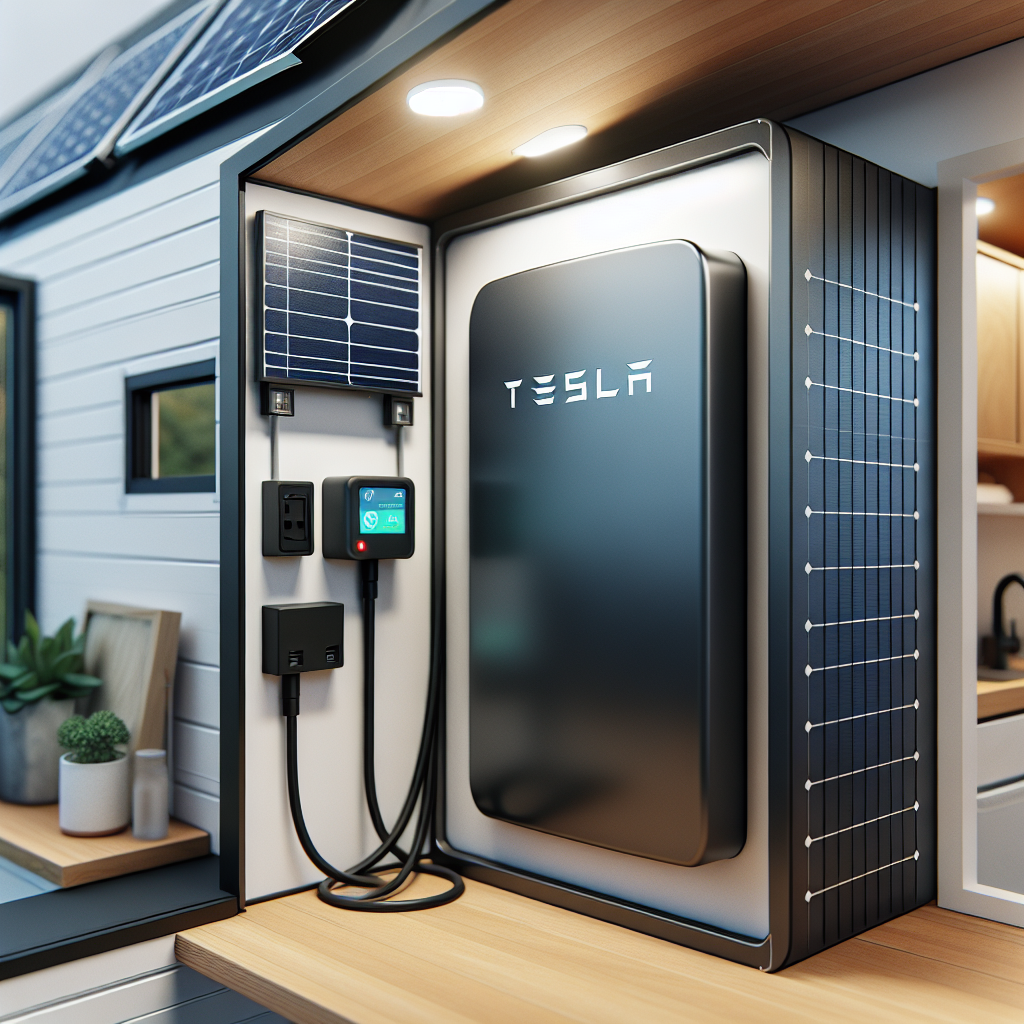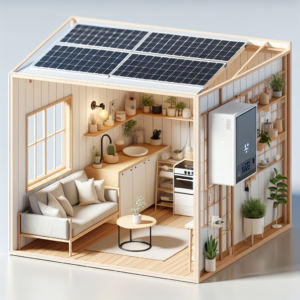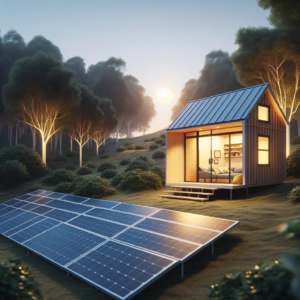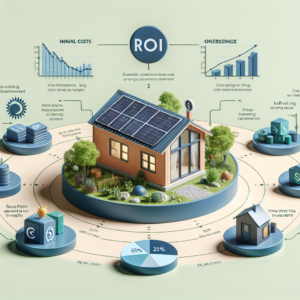
Why Tiny Homes Love the Tesla Powerwall
Imagine your tiny home, nestled in a serene landscape, powered by the sun’s endless energy. This is the vision that Tesla Powerwall brings to life, a vision where compact living meets cutting-edge technology. The Powerwall, a sleek and powerful battery, promises to keep your lights on, your appliances running, and your carbon footprint minimal. It’s a game-changer for those who dream of a self-sufficient, eco-friendly home.
Key Takeaways: Powering Compact Spaces Effectively
-
Compact Design: Tesla Powerwall’s sleek, space-saving design is a perfect match for tiny homes.
-
Efficient Energy Storage: With a capacity to store surplus solar energy, Powerwall ensures you have power when you need it.
-
Smart Management: The Tesla app gives you real-time control and monitoring of your energy use.
-
Reliability: Powerwall’s proven track record offers peace of mind, especially in off-grid settings.
-
Cost Savings: Over time, the Powerwall can lead to significant savings on your energy bills.
The Essentials of Tesla Powerwall for Tiny Living
The Powerwall isn’t just a battery; it’s the heart of your home’s energy system. For those who’ve embraced the tiny home lifestyle, the Powerwall aligns with the values of simplicity and sustainability. It’s not merely about having a backup power source; it’s about transforming the way you live. The Powerwall integrates with solar panels, ensuring that every ray of sunshine is captured and converted into usable energy for your home.
Capacity and Power Output: Ideal for Small Scale
Let’s talk numbers because they matter when it comes to energy. The Tesla Powerwall packs a punch with a 13.5 kWh capacity, making it a powerhouse for your tiny home’s needs. This means you can run your essentials without a hitch, even when the grid goes down. Plus, with a continuous power output of 5 kW, ramping up to 7 kW at peak, it’s got the muscle to handle your daily energy needs effortlessly.
Design and Integration: Blending Form with Function
One look at the Powerwall and you’ll see why it’s the darling of tiny homeowners. Its minimalist, contemporary design doesn’t just look good; it saves space, which is a premium in a tiny home. But it’s not just about looks. The Powerwall is designed to integrate smoothly with your existing solar setup, working in harmony to provide a seamless energy experience. It’s a perfect example of how form and function can come together to enhance your living space.
User Experience: Monitoring and Control at Your Fingertips
Now, let’s talk about control. With the Tesla app, you’re the captain of your energy ship. The intuitive interface lets you monitor your energy production and usage in real-time. It’s like having a conversation with your home’s power system. You can adjust settings, track your consumption, and see exactly how much energy your solar panels are producing. In short, the Powerwall gives you the power to manage your energy with just a few taps on your smartphone.
Living with Tesla Powerwall in a Tiny Home
Living in a tiny home with a Tesla Powerwall is like having a silent, powerful friend who’s always got your back. It stores energy when the sun’s out and steps in when it sets, ensuring that your tiny home is always energized. Whether you’re cooking dinner or reading a book by the light of your eco-friendly LED bulbs, the Powerwall is there to make sure your daily life runs smoothly, without a hitch.
Real-Life Use Case: Off-Grid and On-Point
Meet Alex and Sam, who live in a tiny home in the mountains. They chose the Tesla Powerwall to stay powered up in their off-grid paradise. Even during a week-long winter storm that knocked out power in the nearby town, their lights stayed on, and their electric heater kept them cozy, thanks to the Powerwall’s robust energy storage.
Maximizing Efficiency: Solar Pairing and Energy Management
Pairing the Powerwall with solar panels is like a dance between the sun and your home. The panels soak up the sun’s energy, the Powerwall stores it, and together, they ensure that not a drop of this green power goes to waste. By managing your energy use and timing it right, you can run your home almost entirely off the grid, reducing your energy bills and your environmental impact.
The Financial Breakdown: Cost vs Savings
Let’s talk money. The upfront cost of a Tesla Powerwall might make you pause, but consider the long game. Over time, the savings on your energy bills can more than offset the initial investment. And with potential incentives and rebates, the financial picture gets even brighter. It’s about investing in your future, your independence, and the planet’s well-being—all at once.
Understanding the Investment: Initial Costs and Installation
Investing in a Tesla Powerwall is a significant decision that requires an understanding of both the upfront costs and the installation process. The price tag for a Powerwall may seem steep at first glance, but it’s important to remember that this includes a high-quality battery, a built-in inverter, and the peace of mind that comes with Tesla’s brand and warranty. Installation costs can vary depending on your home’s specific needs, but it’s crucial to have a certified professional handle the setup to ensure safety and efficiency.
Calculating Long-Term Benefits: Is Powerwall Cost-Effective?
When evaluating the cost-effectiveness of the Powerwall, it’s essential to look beyond the initial investment and consider the long-term savings. The ability to store and use solar energy during peak hours means lower electricity bills, and in some areas, you can even sell excess energy back to the grid. Additionally, as utility rates continue to rise, the Powerwall can provide a buffer against these increases, leading to more predictable energy costs over time.
Comparative Analysis: Powerwall Against the Competition
In the realm of home energy storage, the Tesla Powerwall is not the only player. There are several other options available, each with its own set of features and price points. To make an informed decision, homeowners should compare these alternatives in terms of capacity, lifespan, warranty, and integration with existing solar systems. Let’s explore how the Powerwall stacks up against its competitors.
Alternative Options: Exploring the Market
As you navigate the market, you’ll encounter a variety of energy storage solutions such as LG Chem’s RESU, Sonnen’s Eco, and the Enphase Encharge. Each brand offers different advantages, whether it’s in terms of battery capacity, scalability, or compatibility with various solar inverters. It’s important to assess your specific energy needs and preferences to determine which storage solution aligns best with your tiny home’s requirements.
Feature Showdown: Powerwall Vs. Others in Efficiency and Reliability
The Tesla Powerwall shines in its efficiency and reliability, boasting a 90% round-trip efficiency and a 10-year warranty. When compared to alternatives, the Powerwall’s software integration and smart features often give it an edge in optimizing home energy use. However, some competitors may offer better pricing or specific features that cater to different needs. Ultimately, the right choice will depend on balancing these factors against your personal energy goals and budget.
When Powerwall Isn’t Enough: Scalability and Limitations
While the Tesla Powerwall is a robust solution for many, it’s not a one-size-fits-all. There are times when your energy needs might outgrow a single Powerwall. The good news? Powerwalls are designed to work together. Whether you’re expanding your tiny home, adding more power-hungry appliances, or simply want more peace of mind, you can connect multiple Powerwalls to increase your storage capacity.
How Many Powerwalls to Keep the Lights On?
Determining the number of Powerwalls you need is like fitting pieces together in a puzzle. It depends on your energy usage, the size of your solar panel system, and your goals for energy independence. For most tiny homes, one Powerwall is often sufficient. But if you’re aiming for extended off-grid living or full backup for every appliance, you might need two or more. It’s all about tailoring the system to fit your unique energy lifestyle..
FAQ: Powerwall Clarified
Still have questions about the Powerwall? Let’s clear up some common queries to help you make an informed decision.
1.What is the actual capacity of a Tesla Powerwall for running a tiny home?
The Tesla Powerwall boasts a usable energy capacity of 13.5 kWh, which is generally sufficient for the daily energy consumption of a tiny home. This capacity can comfortably power your essential appliances like lights, a fridge, and a laptop for about a day without needing a recharge. However, the actual capacity needed will depend on individual energy usage patterns and the efficiency of the appliances in use.
2.Can multiple Powerwalls be linked for enhanced storage?
Absolutely! You can connect up to 10 Powerwalls together, creating a combined energy storage system that can handle even the most demanding energy needs. This scalability is part of what makes the Powerwall an attractive option for a variety of homes and lifestyles – and is particularly useful for those who live in areas with frequent power outages or for those looking to go completely off-grid.
3.How does Tesla Powerwall perform during extended power outages?
In the event of an extended power outage, the Powerwall can be a lifesaver. It’s designed to provide reliable backup power, and with proper energy management, it can keep your critical appliances running for days.
4.What are the installation requirements for a Tesla Powerwall in a tiny home?
To install a Tesla Powerwall in a tiny home, you’ll need a compatible electrical panel and sufficient wall space for mounting the unit. A stable Wi-Fi connection is also necessary for software updates and mobile app management. It’s crucial to have the installation done by a certified electrician to ensure adherence to safety standards and optimal performance of the Powerwall system.
5.Are there any incentives or rebates for installing a Powerwall in a tiny home?
Many regions offer incentives and rebates for the installation of renewable energy storage solutions like the Tesla Powerwall. These financial benefits can significantly offset the initial investment cost. Homeowners should research local programs, tax credits, and rebates to take advantage of any available savings when installing a Powerwall in their tiny home.
In Conclusion
The Tesla Powerwall stands out as a leading energy storage solution for tiny homes, offering a blend of capacity, reliability, and smart technology. Its ability to integrate with solar power, paired with the convenience of the Tesla app, empowers homeowners to manage their energy use effectively. With options for scalability and financial incentives available, the Powerwall is a compelling choice for those seeking to reduce their carbon footprint and embrace a sustainable, off-grid lifestyle. Whether you’re a tiny home veteran or just starting your journey, the Tesla Powerwall can play a pivotal role in achieving energy independence and peace of mind.



